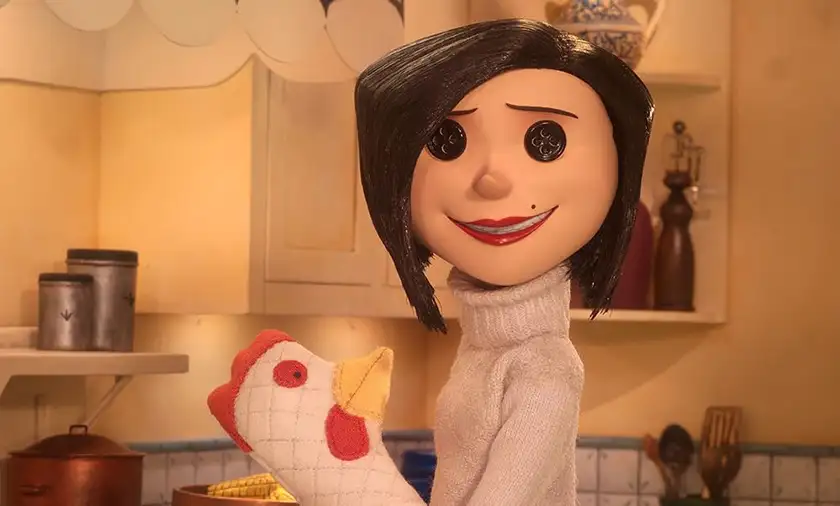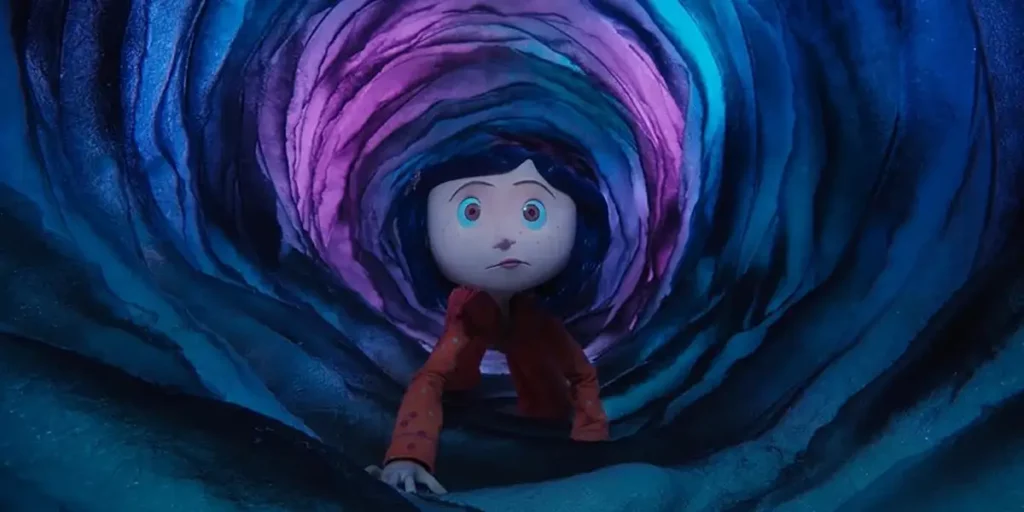Coraline still holds up today as a creepy classic of animation, yet its flawed nature causes some substance to get lost under the style.
Director: Henry Selick
Genre: Animation, Family
Run Time: 100′
Release Date: February 6, 2009
Re-Release: August 15, 2024
Where to watch: in theaters, on digital & VOD
Okay, I know seeing a 3.5/5 rating for this beloved, creepy classic is scarier for some people than anything in this film, but hear me out. Coraline is a stop-motion animated film released in 2009 by then-newcomer Laika. It’s frequently regarded as one of the best animated films ever made, and it’s getting a theatrical re-release for its 15-year anniversary.
Based on the Neil Gaiman novella, Coraline is about … well, Coraline (Dakota Fanning, Once Upon a Time in Hollywood), a girl who’s moved into a run-down house in Oregon with her parents (Teri Hatcher and John Hodgman). While she struggles to adjust to her new life, she finds a portal in her home to an alternate world, where her Other Mother (Hatcher) gives her the paradise she wants … only for the Other Mother to reveal herself as a much darker force than she’d anticipated.
Coraline lets you know right off the bat that it’s not going to be your typical safe and cozy family film, featuring opening credits of a sinister, spindly set of fingers carving a creepy doll set to gothic music and imagery. This is a famously dark movie by kids’ standards, filled with scary visuals and intense situations the likes of which almost no film of its type did at the time. Regardless of my somewhat less enthused opinion on the film as a whole, I can’t praise it enough for succeeding on that front and giving kids the good jolt they probably needed. Coraline doesn’t try to have its cake and eat it too by also pandering to that child audience, either. The film blends its various themes and imagery in an organic, cohesive way that doesn’t cheat anyone. It’s scary for kids and still creepy and interesting for adults.
The visual imagination of Coraline is off the charts. It shows off some amazing designs for environments and supernatural creatures that consistently, thoroughly weave their way between the realms of whimsical and creepy, often being both at once. I mean, just look at the Other Mother. She looks like she could either be your best friend or a nightmare waiting to pounce, and when the latter happens, she takes on one of the most creatively menacing designs I’ve seen in a movie villain. The character in general goes from mildly off-putting to downright grotesque while still maintaining a consistent visual identity. One of the film’s main set pieces is a garden in the Other dimension that’s instantly striking and welcomingly vibrant – seriously, it amazes me how colorful a film this Gothically-charged can get – but it takes very little to turn it into a place of horror.

And dear God, thinking of what it must have been like to actually animate all of this, with stop-motion no less, gives me an aneurysm. So many sequences have so much going on in every frame, but never once does it look even remotely clunky or like the team was being spread too thin. I don’t know if I can call stop-motion my favorite animation form, but films like this make it the one that blows my mind the most. It would be wildly impressive on its own, but throw in great, playful, occasionally twisted angles that make the film look as cinematic as any live-action cinematography could achieve, and you have one of the best-looking animated films ever that still holds up amazingly 15 years later.
So yes, it’s no wonder why Coraline blew so many people away back then, and why reactions are still so enthusiastic … and why that maybe overrides how the story behind all this ingenuity is nowhere near as special. To be absolutely clear, the film works narratively. It gets from point to point smoothly and efficiently, and it provides a decent lesson about valuing what you have and not letting your yearning for a perfect life corrupt you from the warning signs that come with it. I like how Coraline is consistently skeptical of the Other life she finds but slowly gets suckered into it because … well, her real life is doing her very few favors in comparison.
At the same time, Coraline neglects to be wowed by what few good things present themselves to her in the “normal” world, just in an off-kilter, unflattering way on the surface. Her neighbors and surrounding environment provide her with things to appreciate; she just needs a change of attitude by recognizing how creepy the forced generation of an “ideal” life can be. Dakota Fanning is pitch-perfect in the role, getting across her character’s often bratty nature while still making her endearing, and conveying her confusion, fear, and boldness so authentically for this uniquely defined kid character.
But when it comes to flourishes that add dimension to Coraline, that’s as far as it goes. For the most part, this is a very basic story with an almost paper-thin arc for its main character. So much of the storytelling in Coraline is as follows: character reacts to thing, character realizes something, character thus does something else, pause for an elaborate visual spectacle, character goes somewhere else, reacts to new thing, does next thing, etc. I know that’s what pretty much all storytelling is – in the most brain-dead phrasing imaginable – but in the case of Coraline, that’s all it is. It’s not like the arc is even remotely tough to see coming a million miles away, so I guess I need more than what we get on the surface.
The emotions of the story are very rarely dwelled on, and they’re very rushed when they are dwelled on. Coraline seems more intent on getting to the next big set piece or wacky character interaction than it is making you feel something for said characters. Over half of the characters Coraline interacts with in the normal world serve no story purpose other than to be contrasted in the Other world, like a pair of burlesque performers played by Jennifer Saunders and Dawn French, or a gymnast played by Ian McShane. They try to get plenty of laughs, but I didn’t get even a single chuckle on either of my two viewings of the movie. I know I said they show Coraline the good in her world, but it’s not like the film ever shows or focuses on her realizing this.
Most damning of all, I felt no connection between Coraline and her parents. This may have been the point to show why she feels distant from them, but it does the job too well. The father – whose gangly design I find scarier than the Other Mother – only has a few generic father-daughter interactions with Coraline, and the mother … I’m not gonna mince words here: she’s barely better than the creature who wants to sew buttons over Coraline’s eyes. She never acts like she sees Coraline as anything other than a burden, never shows any sympathy for the rough living conditions her child is in – there are bugs in the shower, for God’s sake – and there’s nothing about her that makes me think Coraline should appreciate her other than … well, she’s not a literal monster. That severely sabotages the catharsis for me.
But am I a literal monster for saying Coraline is good but not great? … Don’t answer that. It’s true, though, which saddens me because of how much I love the craft, style, and tone on display here. I won’t go as far as to say Coraline doesn’t deserve the praise it gets to this day. I just don’t gel too much with the substance beneath the style, or at least how that substance is conveyed to us. It’s definitely not my favorite Laika movie – hi, Kubo and the Two Strings – but I still have plenty of respect for it. If you’re a parent whose kid is begging you to take them back to theaters, but you don’t feel like seeing Inside Out 2 again, I’d recommend finding a screening of Coraline this weekend to give them a good but worthwhile scare.
Coraline is now available to watch on digital and on demand. Read our review of Kensuke’s Kingdom.
Loud and Clear Reviews has an affiliate partnership with Apple, so we receive a share of the revenue from your purchase or streaming of the films when you click on the button on this page. This won’t affect how much you pay for them and helps us keep the site free for everyone.

